
In today’s digital age, it’s more important than ever for websites to be accessible and usable on a variety of devices. Responsive design is an approach to web development that allows web pages to adapt to different screen sizes and device types, providing a seamless user experience across all platforms.
At its core, responsive design is all about flexibility. With so many different devices on the market, it’s impossible to create a website that will look and function perfectly on each one. However, responsive design allows web developers to create websites that will adapt to different screen sizes and resolutions, providing a consistent experience for users no matter what device they are using.
The key to responsive design is the use of flexible grids, layouts, and images. Instead of fixed dimensions, elements on the page are sized using relative units, such as percentages or ems. This means that when a user accesses the website on a smaller screen, the layout will adjust and rearrange itself to fit the new dimensions. Images are also sized based on their container, so they will scale up or down to fit the available space.
One of the main benefits of responsive design is that it helps to improve usability and accessibility. Instead of having to zoom in and out or scroll sideways to view content, users can easily navigate the website and access all of the information they need. This can help to reduce bounce rates and increase engagement, as users are more likely to stay on a website that is easy to use and navigate.
Responsive design is also important from an SEO perspective. With more and more people accessing the internet on their mobile devices, search engines like Google have placed a greater emphasis on mobile-friendly websites. Websites that are not mobile-friendly may not rank as well in search results, which can have a negative impact on traffic and conversions.
Improved user experience: With more and more people accessing websites on their mobile devices, it’s crucial that websites are designed to be responsive. A responsive website will adjust to different screen sizes and resolutions, providing a seamless and enjoyable user experience on any device.
Increased mobile traffic: In recent years, mobile traffic has surpassed desktop traffic, and this trend is only expected to continue. Having a responsive website ensures that you are able to capture this growing mobile audience and provide them with a positive experience on your website.
Search engine optimization: Search engines like Google prioritize mobile-friendly websites in their search results. This means that having a responsive website can improve your search engine rankings and make it easier for potential customers to find you.
Cost-effective: Building a separate mobile website can be costly and time-consuming. With responsive design, you only need to build and maintain one website that will work well on all devices.
Future-proof: As new devices with different screen sizes and resolutions are introduced, responsive design ensures that your website will be able to adapt to these changes and continue to provide a great user experience.
In short, responsive design is essential for businesses that want to succeed online and provide their customers with a great user experience, regardless of the device they are using.
Overall, responsive design is an essential part of modern web development. By creating websites that are accessible and usable on all devices, web developers can provide a seamless user experience and improve engagement, accessibility, and SEO performance.